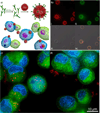A review of current nanoparticle and targeting moieties for the delivery of cancer therapeutics
- PMID: 23262059
- PMCID: PMC3619023
- DOI: 10.1016/j.ejps.2012.12.006
A review of current nanoparticle and targeting moieties for the delivery of cancer therapeutics
Abstract
The tumor microenvironment provides unique challenges for the delivery of chemotherapeutic agents in doses that are effective while ensuring minimal systemic toxicity. The primary limitation of current therapeutics is a lack of specificity in delivery, as they target healthy and cancerous cells alike. The development of nanoscale carriers capable of delivering cancer therapies has the potential to overcome both systemic and tumor barriers and provide specific, targeted delivery. This review seeks to provide an overview of available nanoscale drug carriers by exploring the wide variety of developed nanostructures and the most commonly used moieties for targeted delivery. Additionally, the use of nanoscale carriers will be motivated by examining tumor physiology and the specific barriers present within both the tumor microenvironment and systemic delivery.
Copyright © 2012 Elsevier B.V. All rights reserved.
Figures




References
-
- Adams GP, Weiner LM. Monoclonal antibody therapy of cancer. Nat Biotechnol. 2005;23:1147–1157. - PubMed
-
- Baban DF, Seymour LW. Control of tumour vascular permeability. Adv Drug Delivery Rev. 1998;34:109–119. - PubMed
-
- Boulikas T, Vougiouka M. Cisplatin and platinum drugs at the molecular level. (Review) Oncol Rep. 2003;10:1663–1682. - PubMed
-
- Brannon-Peppas L, Blanchette JO. Nanoparticle and targeted systems for cancer therapy. Adv Drug Delivery Rev. 2004;56:1649–1659. - PubMed
Publication types
MeSH terms
Substances
Grants and funding
LinkOut - more resources
Full Text Sources
Other Literature Sources

